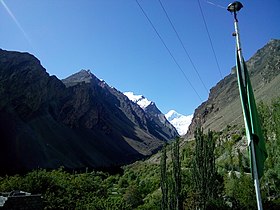This is an old revision of this page, as edited by 37.164.95.206 (talk) at 03:11, 19 February 2022. The present address (URL) is a permanent link to this revision, which may differ significantly from the current revision.
Revision as of 03:11, 19 February 2022 by 37.164.95.206 (talk)(diff) ← Previous revision | Latest revision (diff) | Newer revision → (diff)| This article needs additional citations for verification. Please help improve this article by adding citations to reliable sources. Unsourced material may be challenged and removed. Find sources: "Nagarkhas" – news · newspapers · books · scholar · JSTOR (December 2008) (Learn how and when to remove this message) |
Place in Gilgit–Baltistan, Pakistan
| Nagarkhas نگرخاس | |
|---|---|
 Nagarkhas Nagarkhas | |
| Sovereign state | |
| Dependent territory | Gilgit–Baltistan |
| District | Nagar District |
| Elevation | 2,688 m (8,819 ft) |
Nagarkhas (Template:Lang-ur), also known as Oyumagar is the headquarters of the Nagar District of Gilgit–Baltistan and is one of the largest towns in that district. Situated on the bank of the Nagar River, it was also the capital of the former princely state of Nagar.
Today, the famous Karakoram Highway crosses Nagar, connecting Pakistan to China via the Khunjerab Pass. The road follows the Hunza-Nagar River for some distance through Nagar and into the Hunza District.
Location



Nagar lies in the Nagar River valley, about five miles south-east of the junction of the Nagar River with the Hunza River, just below Baltit.
The Nagar Valley, previously known as Broshal, is situated at an elevation of 2,688m (8822 feet). Nagarkhas is the main town and was the capital of the former princely state of Nagar. The Ghulmet, Minapin, BAR, Chaprote and Hopper Valleys are popular tourist attractions in the Nagar District because of their spectacular scenery. Some of the most intimidating high mountain peaks on earth such as Rakaposhi at 7,788m (25,561 feet), Diran, the Spantik Peak (also known as the Golden Peak), and several others are located in the Nagar District.
History
Main article: Nagar (princely state)Following the Hunza-Nagar Campaign of 1889–1892 (known locally as the Anglo-Burusho war) the area came under British control and then became a vassal of the Kashmir durbar but continued to be ruled by the royal family of Nagar. In 1974, Zulfiqar Ali Bhutto dissolved the princely states of Nagar and Hunza and gave them democratic representation in the Northern Areas Council, now known as the Gilgit-Baltistan Legislative Assembly. The British wanted to expand trade with Russia from both Nagar and Hunza, but the states wouldn't ≤≤≤≤permit them to do so.
References
- Tilman, H.W. (2016), Two Mountains and a River: I made a resolve not to begin climbing until assured by a plague of flies that summer had really come, Vertebrate Publishing, pp. 119–, ISBN 978-1-909461-31-4
Bibliography
- Nicolaus, Peter (2015), "The Taming of the Fairies", in Uwe Bläsing; Victoria Arakelova; Matthias Weinreich (eds.), Studies on Iran and The Caucasus: In Honour of Garnik Asatrian, BRILL, pp. 225–, ISBN 978-90-04-30206-8
Further reading
- Leitner, G. W. (1893): Dardistan in 1866, 1886 and 1893: Being An Account of the History, Religions, Customs, Legends, Fables and Songs of Gilgit, Chilas, Kandia (Gabrial) Yasin, Chitral, Hunza, Nagyr and other parts of the Hindukush, as also a supplement to the second edition of The Hunza and Nagyr Handbook. And An Epitome of Part III of the author's "The Languages and Races of Dardistan". First Reprint 1978. Manjusri Publishing House, New Delhi.
- Where three Empires meet by E.F.Night.
- Buroshall Say Nagar Tak ka Safar by Mohammad Ismail Tehseen.
- Brushaal Ke Qabail by Syed Yahya Shah
- Rakaposhi Nagar (راکاپوشی نگر) (Travelogue, 2015) by Mustansar Hussain Tarar
| Nagar District | |
|---|---|
| Populated places |
|